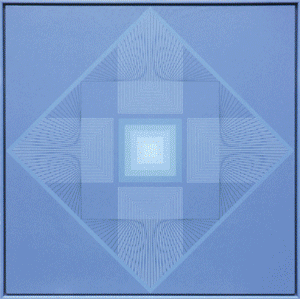- Transmission Difficulties
- Vancouver Painting in the 1960s
- A painting is a pitiable thing . . .
- The experience of a work of art . . .
- A painting is mediumistic . . .
- By Scott Watson
2.
The staging of Vancouver art as an international contender in the 1960s revealed tensions, differences and conflicts. Some of these were felt and articulated at the time; others operated beneath contemporary awareness. On the local scale there was friction between generations - between modernists and postmodernists. Curator Alvin Balkind divined the divide in his 1966 exhibition Beyond Regionalism, in which he encapsulated the situation as the fading away of British Empire Vancouver with the regional school of modernist paintings of abstractions based on nature, and the rise of an urban sensibility plugged into an international discourse.7 Of course, arguments about what constituted important art were not merely local. The pages of Artforum bristled with debate about the direction contemporary art was taking and the direction it ought to take. For the proponents of post-painterly abstraction and for those of Minimalist and/or Pop Art, the fate of painting was the subject of the liveliest New York debates as well as a topic of intense local interest.8 At the beginning of the decade, the status of painting as the activity of art was hardly in doubt. By mid-decade, despite its continuing central role in the modernist argument, painting was being eclipsed by process, conceptualism and involvement with new media. By the end of the decade, painting appeared to be over. The Bomb had exploded, as Jack Burnham wrote: "Art that renaissance product, no longer exists; only the art world and its burn off are left."9
An essay like this, focused on painting, is a priori arbitrary . . .
The staging of Vancouver art as an international contender in the 1960s revealed tensions, differences and conflicts. Some of these were felt and articulated at the time; others operated beneath contemporary awareness. On the local scale there was friction between generations - between modernists and postmodernists. Curator Alvin Balkind divined the divide in his 1966 exhibition Beyond Regionalism, in which he encapsulated the situation as the fading away of British Empire Vancouver with the regional school of modernist paintings of abstractions based on nature, and the rise of an urban sensibility plugged into an international discourse.7 Of course, arguments about what constituted important art were not merely local. The pages of Artforum bristled with debate about the direction contemporary art was taking and the direction it ought to take. For the proponents of post-painterly abstraction and for those of Minimalist and/or Pop Art, the fate of painting was the subject of the liveliest New York debates as well as a topic of intense local interest.8 At the beginning of the decade, the status of painting as the activity of art was hardly in doubt. By mid-decade, despite its continuing central role in the modernist argument, painting was being eclipsed by process, conceptualism and involvement with new media. By the end of the decade, painting appeared to be over. The Bomb had exploded, as Jack Burnham wrote: "Art that renaissance product, no longer exists; only the art world and its burn off are left."9
An essay like this, focused on painting, is a priori arbitrary . . .

